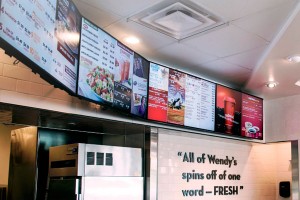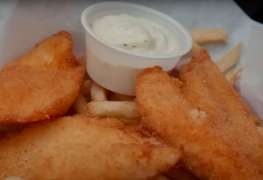 Five years ago, the then CEO of Wendy’s International issued a directive that “when the QSR (Quick-Service Restaurant) industry went all digital, we needed to be ready with a fully scalable, operational, supportable solution for the entire brand,” remembers Nick DeCarlo, Director, Restaurant Solutions at Wendy’s. Today, Wendy’s has approximately 2,500 media players running digital menu boards powered by Scala software in many of its nearly 6,500 North American corporate and franchise restaurants.
Five years ago, the then CEO of Wendy’s International issued a directive that “when the QSR (Quick-Service Restaurant) industry went all digital, we needed to be ready with a fully scalable, operational, supportable solution for the entire brand,” remembers Nick DeCarlo, Director, Restaurant Solutions at Wendy’s. Today, Wendy’s has approximately 2,500 media players running digital menu boards powered by Scala software in many of its nearly 6,500 North American corporate and franchise restaurants.
“It wasn’t an easy journey for us,” DeCarlo says. “We went through several companies before we found what we were looking for.” What the other content management software companies lacked that Scala brought to the table was “getting the right content to the right display at the right store at the right time. That’s all that matters. If you can’t do that, that software doesn’t mean anything to us.”
Process and results
The third largest QSR chain in the world, Wendy’s restaurants have different menus and pricing mechanisms to be displayed on digital menu boards. This required them to find an application program interface (API) that could “scale with us,” DeCarlo says. Scala’s platform is flexible and easy to customize, either by individual store managers right onsite or by calling Scala support. “Putting control of dynamic content in the restaurant managers’ hands is huge,” DeCarlo says, because there are no set dates for knowing when content will need to change. “Sometimes it’s when they run out of product.” Other key benefits to working with Scala has been Scala Designer, which enables Wendy’s information technology team to easily upload custom designed and optimized content to individual restaurants—all with a small footprint. “Our slogan is ‘quality is our recipe’ and we want that to apply to everything we do,” DeCarlo says, and that means offering the highest-quality solution they could to show their food in the best possible light.
Future work
Now that the hard work of finding hardware and software that meets their needs is behind them, “it’s time for the fun stuff,” DeCarlo says. This means experimenting with digital menu boards at drive-through windows, which comprises 65% of Wendy’s business and has been test marketed in Boston, Columbus and Phoenix. In some instances, like Phoenix, weather proved to be a challenge technically and financially. “It just required too much air conditioning and electricity to keep the units cool to be cost beneficial,” DeCarlo says. More successful test programs have been queuing menu boards via Twitter, which was especially popular with teenagers. “We’re curious to see how that affects retention… how we can use it for loyalty programs,” DeCarlo says. Wendy’s is also looking into using Scala software for mobile app integration as well as limited time offers and feature items. “These are big areas of opportunity in the digital signage field we are waiting to make a breakthrough on,” DeCarlo concludes.









Leave a comment